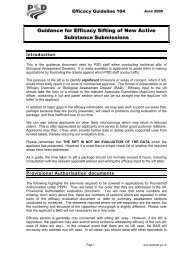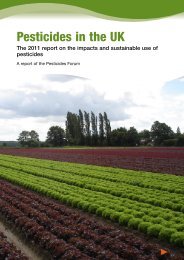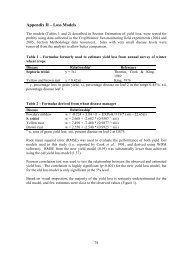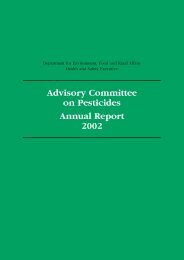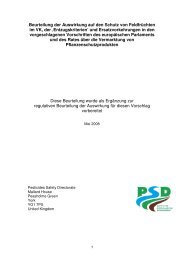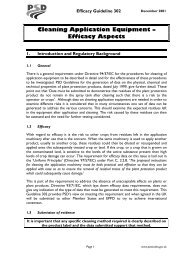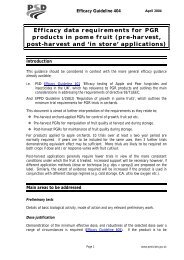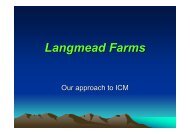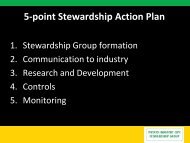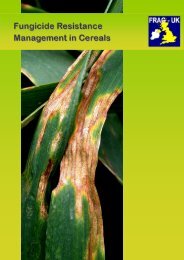Advisory Committee on Pesticides Annual Report 2001
ACP Annual Report 2001 - Pesticides Safety Directorate
ACP Annual Report 2001 - Pesticides Safety Directorate
Create successful ePaper yourself
Turn your PDF publications into a flip-book with our unique Google optimized e-Paper software.
Secti<strong>on</strong> F: Other items c<strong>on</strong>sidered during the year<br />
The most frequently used growth regulators by area treated were paclobutrazol,<br />
62 percent, gibberellins, 34 percent, and carbaryl, three percent, with<br />
paclobutrazol and carbaryl accounting for 50 percent and 44 percent<br />
respectively by weight applied.<br />
The most extensively used acaricides were amitraz, which accounted for<br />
42 percent of the acaricide-treated area, fenpyroximate, used <strong>on</strong> 34 percent,<br />
and clofentezine, comprising a further 20 percent. By weight applied, amitraz<br />
accounted for 83 percent of the total. Tebufenpyrad was the <strong>on</strong>ly<br />
acaricide/insecticide recorded.<br />
Biological c<strong>on</strong>trol agents represented less than <strong>on</strong>e percent of all pesticide<br />
usage, with Bacillus thuringiensis being the <strong>on</strong>ly agent recorded. Anthracene<br />
oil was the <strong>on</strong>ly defoliant recorded.<br />
<strong>Report</strong> 173: Hops in Great Britain 2000<br />
This report presented informati<strong>on</strong> c<strong>on</strong>cerning all aspects of pesticide usage <strong>on</strong><br />
hops in England and Wales during the 2000 cropping seas<strong>on</strong>. Informati<strong>on</strong> was<br />
collected from visits to 41 holdings, which represented 32 percent of the total<br />
area of hops grown. Data collected <strong>on</strong> the area of pesticide treatments and the<br />
amount of active substances applied had been extrapolated to give estimates<br />
of nati<strong>on</strong>al pesticide usage.<br />
71<br />
There had been a c<strong>on</strong>tinual decrease in the area of hops grown in recent<br />
years, with the area grown in 2000 being 35 percent less than in 1992 and<br />
32 percent less than at the time of the previous survey in 1996. Since 1996,<br />
there had been a 26 percent decrease in the total pesticide-treated area, and<br />
a 54 percent decrease in the weight of active substances applied.<br />
Pest and disease c<strong>on</strong>trol in hops is frequently achieved using routine spray<br />
programmes, particularly in the case of protectant fungicide sprays to c<strong>on</strong>trol<br />
downy and powdery mildew. On average, crops received 14 separate spray<br />
applicati<strong>on</strong>s, 25 products (including repeat applicati<strong>on</strong>s of the same product) and<br />
30 active substances (including repeat applicati<strong>on</strong>s of the same active substance).<br />
Fungicides accounted for 59 percent of the total pesticide-treated area of hops<br />
grown in England and Wales in 2000, herbicides 19 percent, acaricides eight<br />
percent, sulphur six percent, insecticides four percent, defoliants three percent<br />
and molluscicides and tar oils less than <strong>on</strong>e percent. In terms of the weight of<br />
active substances applied, herbicides accounted for 34 percent of the total,<br />
fungicides 23 percent, defoliants 23 percent, sulphur 12 percent, tar oils seven<br />
percent, acaricides, insecticides and all other groups less than <strong>on</strong>e percent.




